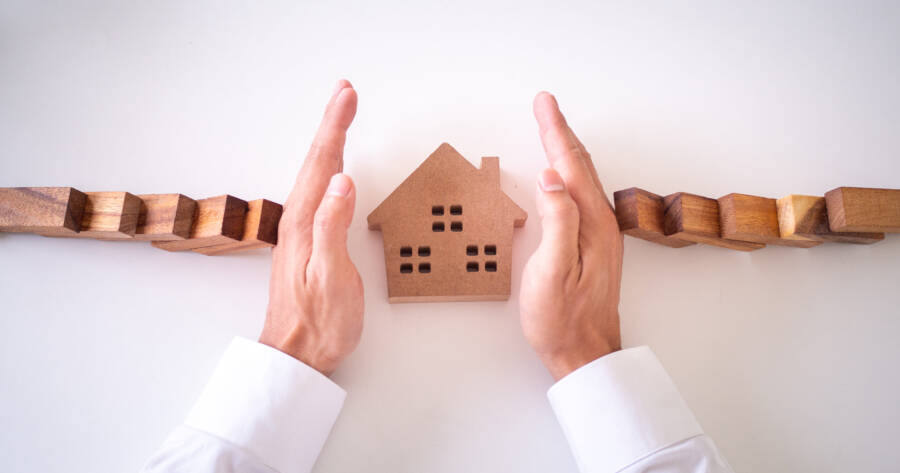Owning a home can be an overwhelming process. On top of the mortgage payments, there are a ton of other oft forgotten costs. One of these extra expenses is homeowner’s insurance. Trying to navigate the house insurance world can deter some potential homeowners from buying their place. However, if you simply do a little bit of research, the process is suddenly much less daunting. There are multiple types of home insurance. In this article, we’ll help uncover the meaning behind the HO3 insurance policy. In many ways, it’s simply considered the “standard policy” for most homeowners. You’ll learn what to look for in an HO3 policy, what’s covered (and what’s not), and how you can purchase additional coverage if you so choose.
By the end of this guide, you’ll know more about homeowners insurance than most people do. Are you ready to get started?
Why Should You Have HO3 Insurance?
Your home is probably the biggest purchase of your life (for most of us, at least). Insuring your home protects the hundreds of thousands of dollars’ worth of value within such an asset. Homeowner’s insurance is typically always required by your mortgage lender. So unless you’re paying cash for your home, you’ll need insurance. Your lender wants their investment in the property protected too.
Like any other type of insurance, the idea is to have suitable coverage that will pay for large expenses if anything goes awry. If you’re old enough to own a home, you know that life happens. It could be something small like a tree branch falling through a window. It could be something big a hole in your roof after a strong thunderstorm. A total disaster is even possible, like an accidental house fire.
There are many different types of home insurance policies. A standard policy covers the structure of the home, your personal belongings, plus “lawsuits for bodily injury or property damage that policyholders or family members cause to other people.” It will also cover additional living expenses for cases where your house becomes uninhabitable. So if you’re stuck in a hotel for a while your house gets repairs, insurance should cover that bill. While this might sound like a pretty comprehensive list of coverages, the homeowners insurance policy can be broken down even further.
Homeowners Insurance Policy Types
One of the easiest ways to differentiate homeowners insurance is to refer to the numbered system below. Like we said, there are multiple types of home insurance — even if you don’t own your primary residence. Here’s a quick breakdown of the various types of home insurance you can get.
HO1
This is a bare bones policy, and one that isn’t always widely available. If you are on the tightest of budgets or just need insurance to satisfy your lender, you might look into HO1 insurance. However, it doesn’t provide much coverage and most lenders require something a little more robust.
HO2
These policies are smidge more than the minimum requirement. They have limited coverage that addresses less than that of a typical HO3 policy. Again, unless you’re absolutely struggling financially, we suggest you protect your home with a policy that’s a bit more secure.
HO3
This is known as the standard homeowners insurance policy, which we will discuss further in detail below. The exact coverage amounts can usually be finessed a little, but HO3 insurance is what most people are talking about when it comes having home insurance.
HO4
Similar to the HO3 policy, the HO4 was “created specifically for those who rent the home they live in.” In other words, it’s Renter’s Insurance. In this article, we explain more about Renter’s Insurance and why it’s important.
HO5
This type of policy gives you a bit more room when it comes to “acceptable perils.” We’ll discuss exactly what counts of a perils in the next section. Until then, just know that HO5 policies give you “more peril coverage under an open peril policy.” You’ll probably pay a slightly higher premium for this type of coverage. However, it could be worth it for homeowners with higher personal property values or those in certain geographic areas.
HO6
Policyholders of an HO6 type of insurance own condominiums and cooperative units. If you own a condo, you can read more about HO6 insurance in this article.
HO7
Mobile homes and/or manufactured homes are covered under this type of policy. If you own (or live in) a trailer, RV, or even one of those house trailers, you can look into HO7 insurance.
HO8
This policy covers older homes. Since they were often built with now-outdated technology (like heating and electrical components), older homes often have different insurance needs.
As you can see, each of these policies covers something different. You’ll want to keep these particulars in mind as you shop for homeowners insurance for your property.
What is an HO3 Insurance Policy?
Now that you’ve got a better idea of how homeowners insurance policies are differentiated, let’s take a closer look at the HO3 insurance policy.
In short, the HO3 policy covers “both damage to property and liability or legal responsibility for any injuries and property damage policyholders or their families cause to other people. This includes damage caused by household pets.”
Since “damage” is quite a broad term, most insurance policies name a list of “perils” that are acceptable. These are the causes of the damage sustained to your home or personal property. We’ll go over the most common perils covered by your HO3 policy in the next section. There are also some things that specifically aren’t covered. You should know about both.
For many policies, the types of coverage you receive are listed under subcategories. Here’s a breakdown of the coverage particulars you might expect on an HO3 policy.
Section A
This section of coverage addresses the home you live in and any attached structures, such as a garage, deck, or porch.
Section B
This covers any unattached structures, such as sheds, fences, and pools.
Section C
You might easily remember this one for the “contents” of your home or personal property.
Section D
Sometimes called “loss of use coverage,” this section comes into play when your home becomes uninhabitable for any reason.
Section E
Should you be held personally liable for any damage, this section will cover the cost of the legal fees associated to defend you and/or pay any damages you are deemed responsible for.
Coverage Under an HO3 Insurance Policy
We mentioned the term “perils” before. It can refer to a variety of things relating to losses or personal property damage. Just think about the many ways your house could be damaged, whether it’s total destruction or simply a small cosmetic defect.
There are two types of perils when it comes to HO3 policies: named and open. Named perils are the ones listed below. Open perils describes the policy you hold, which likely doesn’t limit you to just the 16 listed here. Here are the most obvious named perils in most standard HO3 insurance policies.
- Theft
- Falling object
- Damage caused by aircraft
- Riot or civil commotion
- Freezing of plumbing, heating, AC, sprinkler system, or household appliance
- Windstorm or hail
- Fire or lightning
- Smoke
- Vandalism or malicious mischief
- Tearing, cracking, burning, or bulging of a hot water heating system, AC or sprinkler system
- Damage caused by vehicles
- Explosion
- Volcanic eruption
- Weight of ice, snow, or sleet
- Accidental discharge/overflow of water from plumbing, heating, AC, household appliance, or sprinkler system
- Sudden and accidental damage from artificially generated electrical current.
For some, it might be better to consider what an HO3 policy doesn’t cover.
HO3 Insurance Policy Exclusions
Unfortunately, there are certain perils that are not covered by a typical HO3 policy. These include the following things.
- Earthquakes
- Mudslides
- Sewer backups
- Ordinance updates
- Government seizures
- Flooding
- Mold
- Pollutants
- Insect or animal damage
- General wear and tear
- Power failure
- Collapse
- Neglect/intentional loss
- Settling
- Nuclear hazard
- Construction theft
- War
- Mechanical breakdown
One of the best things you can do is make sure you’re clear on what is and isn’t covered by your HO3 policy. To do that, make sure you speak to your insurance agent before agreeing to anything. In fact, you should ask them for a detailed list of what is and isn’t covered. It would be useful to reference later, should damage occur.
You can also add-on certain types of coverage to your standard HO3 policy. This includes flood insurance from the National Flood Insurance Program. A lot of HO3 policies don’t include flooding (as listed above). If you live anywhere that is at risk of flooding, ask your insurance agent for more details about this type of purchasable coverage.
Make Your HO3 Insurance Work For You
Beyond having to purchase home insurance on account of your lender, having coverage is always a good idea. You never know when life will get a little hair — or smoky, wet, etc. That’s really what insurance is all about. You don’t want to be hit with a major surprise expense just because you had a pipe burst. That can quickly turn your dream home into a nightmare.
So stay knowledgeable about your home insurance. Make sure you have adequate coverage and stay on top of paying your premiums. You’ll be glad you did the next time disaster strikes and you need to call someone for repairs. Hopefully, you won’t have to sift through the fine print of your policy and realize you’re missing coverage that you need.
 Shutterstock
Shutterstock

